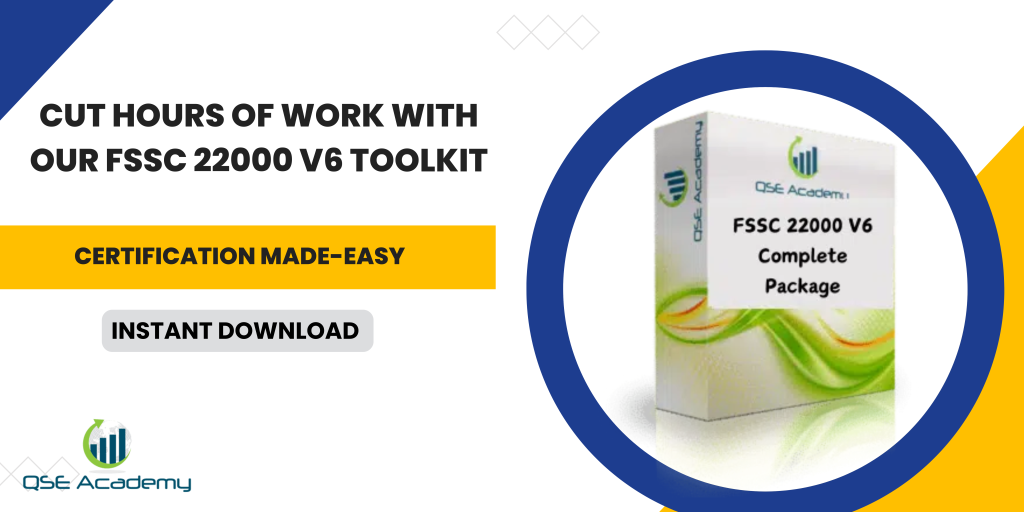FSSC 22000 V6 Transition Guide: Moving from V5.1
A Clear Path for Your Transition
Transitioning from FSSC 22000 V5.1 to Version 6 isn’t just a compliance update — it’s a structured shift toward stronger verification, measurable performance, and clearer evidence of food safety maturity.
If you’re managing an existing certification, you already have a strong foundation. What you need now is clarity: what changed, what must be updated, and how to implement the transition in a logical sequence so the certification audit goes smoothly.
This guide gives you a complete roadmap, from understanding the new requirements to updating documentation, training your team, and preparing for the transition audit. The goal is simple: make your move to FSSC 22000 V6 organized, controlled, and fully aligned with what auditors will expect.
Understanding the Scope of the Change
The shift from V5.1 to V6 was driven by several factors: alignment with ISO 22003-1:2022, strengthened GFSI expectations, and real-world audit findings from earlier versions.
Many core concepts remain the same, but the emphasis has changed. Version 6 focuses on:
- Measurable culture performance
- Stronger environmental monitoring
- Clearer PRP expectations
- More explicit verification and trending
- Evidence-based compliance rather than written statements
Before modifying anything, review the standard with the lens:
“Do we already meet this requirement operationally, or do we need documentation, evidence, or validation to demonstrate compliance?”
Pro Tip: A clause-by-clause comparison table makes this process significantly faster and improves team alignment.
 Transition Timeline and Certification Requirements
Transition Timeline and Certification Requirements
Transition deadlines are fixed, and certification bodies will enforce them. Organizations must fully transition to FSSC 22000 V6 within the defined auditing cycle.
Factors affecting scheduling include:
- Audit cycle timing
- Readiness of documentation
- Internal audit completion
- Evidence maturity (EMP, culture, training records)
Plan backwards from your transition audit date. Build a timeline that includes:
- Gap analysis
- Procedure and PRP updates
- Staff awareness and auditor training
- Internal audit and corrective action closure
- Management review
Common mistake: waiting until just before the scheduled audit. Version 6 requires evidence built over time — especially for culture metrics and trend analysis.
Conducting a Structured Gap Analysis
A gap analysis is the most practical starting point. It shows exactly where your existing system aligns with V6 and where improvements are needed.
A good gap-analysis approach includes:
- Reviewing each requirement in V6
- Comparing it to current documented controls
- Scoring compliance (compliant / partial / missing)
- Recording required actions, responsible persons, and deadlines
Focus attention on the areas where most changes occurred:
- Additional Requirements
- EMP
- Culture verification
- Documentation linking and validation
Color-coding your findings helps visualize risk and action priority.
Updating Documentation, PRPs, and Operational Controls
Version 6 reinforces the expectation that documentation must reflect practice — not just theory.
Documents commonly requiring updates include:
- PRPs aligned with the correct ISO/TS 22002 series
- Allergen control procedures and verification steps
- EMP programs including trend analysis
- Food fraud mitigation and defense plans
- Maintenance and calibration programs
- Document control and record retention procedures
Make updates clear, purposeful, and traceable.
Reminder: Each update should be supported by:
- A procedure
- A record format
- Evidence of implementation
- Verification and validation where applicable
Strengthening People Systems: Culture, Competence & Training
Version 6 places measurable emphasis on Food Safety and Quality Culture. A policy alone isn’t sufficient — auditors expect evidence of engagement and ongoing evaluation.
Examples of measurable activities include:
- Training completion and knowledge demonstration
- Culture surveys
- Incident-linked improvements
- Operator involvement in food safety discussions
- Performance indicators integrated into leadership review
Training must also reflect the new requirements, especially for:
- Internal auditors
- Supervisors
- EMP and sanitation personnel
- Maintenance and calibration teams
Competence records must demonstrate both participation and performance.
Upgrading Internal Audits to Meet V6 Expectations
Internal audits must now evaluate:
- New and revised clauses
- Additional requirements
- Culture implementation
- EMP execution and data trending
- PRP improvements and verification controls
Internal auditors must be trained on V6 expectations. Evidence of that competence will be reviewed during the transition audit.
Implementing and Verifying the EMP
The Environmental Monitoring Program is now a mandatory element for many categories and a significant area of audit focus.
A compliant EMP includes:
- Defined sampling plan
- Justified site selection
- Routine verification
- Trending and data analysis
- Documented corrective actions
EMP must integrate with sanitation, zoning, hazard analysis, and PRP effectiveness measurement.
Updating Additional Requirements
The Additional Requirements section is one of the areas with the greatest expansion in V6. Each requirement should be treated as a standalone compliance element with supporting evidence.
Key areas include:
- Allergen management
- Food defense and fraud mitigation
- Environmental sustainability considerations
- Quality control and product tests
- Supplier approval and monitoring
- Equipment and tool hygiene
Each must be documented, implemented, and verified.
Your Transition Action Plan
A practical sequence for completing the transition:
- Review FSSC 22000 V6 requirements
- Complete a gap analysis
- Update documentation and PRPs
- Train internal auditors and operational staff
- Implement new monitoring and verification activities
- Conduct an internal transition audit
- Perform management review
- Schedule and complete the transition certification audit
Assign roles and owners to keep progress controlled and visible.
Common Pitfalls and How to Avoid Them
Areas where organizations typically struggle include:
- No measurable food safety culture evidence
- EMP without trending or corrective-action linkage
- Documentation inconsistencies during revision
- Lack of updated internal audit scope or auditor competence
- Missing proof of validation for allergen cleaning and sanitation procedures
One early adopter shared that the shift wasn’t difficult — but the expectation for evidence maturity was much higher than anticipated.
Tools and Resources to Support Your Transition
Recommended resources include:
- Gap-analysis worksheets
- Internal audit checklists
- Updated PRP templates
- EMP documentation and trending tools
- Transition implementation trackers
- Competence and training matrices
Using structured tools shortens preparation time and improves implementation consistency.
FAQs
How long does a typical transition take?
Most organizations require 8–12 weeks, depending on documentation maturity and operational readiness.
Do all teams need new training?
Only those affected by revised requirements — but awareness training for all personnel is recommended.
Will the transition require a full recertification audit?
The certification body determines audit scope based on audit cycle and organizational readiness.
Conclusion: A Confident Path Forward
Moving to FSSC 22000 V6 is a chance to strengthen systems, improve visibility, and demonstrate maturity — not just compliance.
With a structured approach, trained teams, documented evidence, and well-planned internal verification, the transition becomes predictable and manageable.
If you’re ready to move forward efficiently, the next step is to begin your structured gap analysis and align your action plan with the requirements outlined here.
Melissa Lavaro is a seasoned ISO consultant and an enthusiastic advocate for quality management standards. With a rich experience in conducting audits and providing consultancy services, Melissa specializes in helping organizations implement and adapt to ISO standards. Her passion for quality management is evident in her hands-on approach and deep understanding of the regulatory frameworks. Melissa’s expertise and energetic commitment make her a sought-after consultant, dedicated to elevating organizational compliance and performance through practical, insightful guidance.








